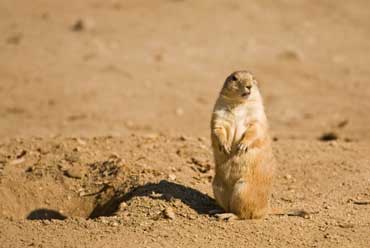 Groundhog Day is February 2
Groundhog Day is February 2
Important Facts:
- Groundhog sees shadow, six more weeks of winter
- No shadow, winter is over.
According to legend, the groundhog is supposed to awaken on February 2, and come up out of his burrow.
If it is a sunny day and the groundhog sees its shadow, according to folklore it becomes frightened and returns to its hole to sleep, and winter will last another six weeks.
If it does not see its shadow, it remains outside because the worst of winter is over and warmer weather is on its way.
Why February 2? THE TRADITION
In the mid-18th century, German immigrants in Pennsylvania brought to the United States the tradition of watching the groundhog for signs of spring. They chose Feb. 2, the Christian holiday of Candlemas. Candlemas is a "cross-quarter" day, about halfway between the winter solstice in December and the vernal equinox in March, and is celebrated in some cultures as the midpoint of winter. Traditionally, it was believed that if Candlemas was sunny, the remaining six weeks of winter would be stormy and cold. But if it rained or snowed on Candlemas, the rest of the winter would be mild. If an animal "sees its shadow," it must be sunny, so more wintry weather is predicted:
Groundhogs
The groundhog, often called a woodchuck, is the only mammal to have a day named in his honor. Woodchuck and groundhog are common terms for the same animal, the rodent with the scientific name of Marmota monax. Most closely related to squirrels, groundhogs can actually climb trees and also swim. In the winter, not much happens. Groundhogs go into profound hibernation(almost like a coma), greatly reducing their metabolic rate, and their body temperature drops to just a few degrees above ambient temperature. The burrow where they hibernate, is below frost line so it never freezes in the burrow.
Why do Groundhogs wake up?
The groundhog's internal clock is believed to be affected by annual changes in the amount of daylight. Hormonal responses to cyclic changes in production of melatonin, a sleep-related hormone, are thought by some to be the signal to wake up.
How accurate is the groundhog?
According to organizers the groundhog is right 70-90% of the time. According to meteorological records the groundhog gets it right only 35% of the time, which is actually worse than flipping a coin(50/50).
Famous Groundhogs:
- Punxsutawney Phil
- Dunkirk Dave
- Shubenacadie Sam
- Wiarton Willie
- General Beauregard Lee
- Peewee the Woodchuck
- Staten Island Chuck
Facts:
- The Celts celebrated the 2nd as Imbolc, a beginning-of-spring festival.
- Groundhog Day as we know it began with newspaper editor by the name Clymer Freas. In 1887, Freas heard about a group of hunters and businessmen, known as the Punxsutawney Groundhog Club, who held an annual groundhog hunt and picnic at Gobbler’s Knob. He thought this fun tradition should be shared with the rest of the city and wrote about it every year. Gobbler’s Knob groundhog festivities have lasted until today..
-
The legend of Groundhog Day has been spotted in two old British songs.
In a Scottish couplet, it says: "If Candlemas Day is bright and clear, there'll be two winters in the year."
In an English song: “If Candlemas be fair and bright, come, Winter, have another flight; If Candlemas brings clouds and rain, go Winter, and come not again” - In some areas there are German-Pennsylvanian Groundhog Lodges that hold big parties with traditional German food and skits. Pennsylvanian-German dialect is the only language allowed - if you speak in English you have to pay a small fine as punishment.
- The most famous groundhog is Punxsutawney Phil, who has apparently been making predictions in Punxsutawney for over 125 years. Residents say that Phil is given a magical potion every year to give him long life.
- The groundhogs are looked after by the Inner Circle, which is a group of local dignitaries who are responsible for carrying out all of the Groundhog Day celebrations. They traditionally wear formal dress, including top hats, on Groundhog Day.
- According to Scientific American, the term “woodchuck” has nothing to do with chuckin’ wood, but rather stems from the Algonquin name for the animal, wuchak. In fact, their diets mostly consist of plants, fruits and tree bark.
- You will not find any groundhog fur coats, but the American Indians used woodchuck hides to make moccasin soles.
- Groundhogs can only live about 4-6 years in the wild, and up to 10 years in captivity. However, Punxsutawney Phil supposedly drinks a “magical” elixir at the Groundhog Day picnic, which some insist has kept him alive for more than 126 years!
- The average groundhog is 20 inches long and normally weighs from 12 to 15 pounds.
- A groundhog eats greens, fruits, and vegetables. They drink very little water because most of their water comes from the dew on plant leaves
- Canada, got its first groundhog in 1956 , Wiarton Willie became a household name for his early February prognostications. Wiarton is a pretty town of 2,300 on the Bruce Peninsula between Lake Huron and Georgian Bay.
|
|
